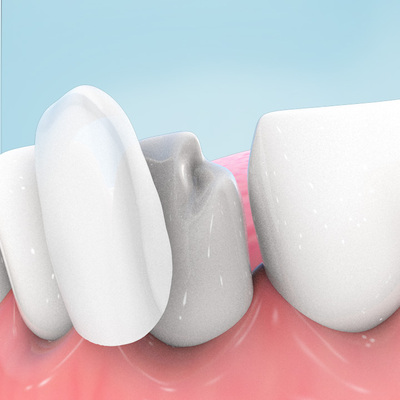
The most valuable benefit of improving your smile with dental veneers is working with your dentist on a custom design that meets your ideal smile goals. Dental veneers cover the visible aspects of the teeth and can improve a wide variety of smile issues, like minor gapping, crowding, or teeth that appear too small. However, veneers are simply cosmetic solutions to cosmetic problems. Underlying teeth need to be healthy prior to veneer placement.





The most valuable benefit of improving your smile with dental veneers is working with your dentist on the custom design. Your dentist can create a smile that is unique and natural, meeting your ideal smile goals.

Some people are confused by the differences between dental veneers and dental crowns. Both can accomplish cosmetic changes on the front teeth to improve the appearance of the smile. The difference is in how much of the teeth they cover. Veneers only cover the visible portion of the teeth and do not strengthen the teeth structurally. A crown covers the entire exposed portion of a tooth (everything except the root), and does add strength to a weakened tooth.
Your dentist uses dental crowns to repair teeth that have suffered from large decay, fractures or severe wear. Some people who are not candidates for dental veneers may be able to accomplish their smile goals through dental crowns.
Traditional veneers are made from porcelain and require the removal of several millimeters of enamel from each tooth being covered. Because these veneers require more preparation of the teeth, your dentist is capable of making more drastic changes in color, shape, and alignment when using this material. Porcelain is beautifully glossy and transparent, closely mimicking the appearance of a natural tooth.
Composite veneers come in both traditional and no-prep varieties. The important difference in these veneers is that they are not made in a dental laboratory like porcelain veneers. Instead, your dentist applies the material directly to the teeth, making the veneers inside your mouth. This provides several advantages, such as no need for temporary veneers and immediate results, meaning your appointment is complete in only a single visit. However, composite material is not as strong, glossy or shiny as porcelain, but still offers a way of reshaping teeth similar to veneers. If damaged, composite material may chip or crack, but your dentist can repair it immediately. In contrast, porcelain veneers cannot be repaired; they must be replaced.
Which is Best for Me?
In order to decide which type of veneer is right for your smile goals, discuss your concerns and desires thoroughly with your dentist. As we mentioned, there are limitations to different types of veneers, so your dentist will need to guide you to which options are best for you.

Once you’ve communicated clearly your desire for the appearance of your new smile, you will schedule an appointment with your dentist to gather information. This will include taking digital scans of your teeth as well as photos of your smile. This information guides your dentist in the planning process.
During your next visit, your dentist prepares the teeth based on the type of veneer you’ve selected. For traditional porcelain veneers, your dentist will use anesthetic to “numb” your teeth so you’re comfortable during the preparation. After preparing the teeth and taking another digital scan, your dentist will cover the teeth with temporary veneers. You’ll receive detailed instructions on how to properly care for your temporary veneers until you come back for the placement of your final veneers.
Typically, porcelain veneers require about two to three weeks in the lab for fabrication. Once the veneers are complete, you will return to your dentist for removal of the temporary veneers, try-in of the porcelain veneers, and, after approval, permanent bonding of the veneers to your teeth.
Make sure to keep up with consistent follow-up care and professional teeth cleanings so your veneers have a long, healthy lifespan.
When properly cared for, veneers can last for many years. Maintenance of veneers requires great teamwork between you and your dentist through a combination of home care and consistent dental visits.
Prevent Cavities
If decay develops on a tooth that has a veneer covering, your dentist may have to remove the veneer and replace it with a filling and new veneer or a new crown. You can prevent cavities through diligent home care and consistent professional cleanings.
Home Care
In order to prevent cavities from developing on your teeth (and under your veneers), you must consistently and effectively remove dental plaque. Every day, commit to great brushing and flossing techniques. Reduce your intake of acidic and sugary beverages and use products recommended by your dentist to strengthen your tooth enamel.
Professional Care
It’s important to see your dentist and dental hygienist on a regular basis for follow-up visits, especially once you have dental veneers. Your dental hygienist will perform professional teeth cleanings twice each year, removing dental plaque and hardened tartar buildup from areas you have missed. Your dentist will evaluate your mouth for any risk factors or signs of dental disease that have changed since your previous visit.
Prevent Chipping and Debonding
One of the most common reasons veneers require replacement is due to chipping or debonding. “Debonding” means the veneer has come off the tooth in a single piece. This usually occurs as the result of clenching or grinding, a habit that many do subconsciously during sleep.
The simplest and most effective way to protect your veneers from the effects of teeth clenching is through wearing a professional, custom-made nightguard. This hard appliance covers the teeth, protecting them from friction against the opposing teeth and reducing the amount of muscle force the jaws can produce.
Mon – Thu: 8am – 5pm
Fri: 8am – 12pm
Sat: By Appointment Only
Sun: CLOSED
Turtle Creek Dental Associates © 2025 | All Rights Reserved